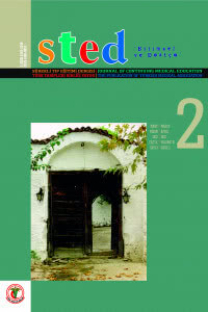Sağlık Bilimleri Eğitiminde Benzetim Temelli Meslekler Arası Öğrenmenin Öğrencilerin Birey ve Ekip Performanslarına Etkisi
The Effect of Simulation-based Interprofessional Learning on the Health Sciences Students' Individual and Team Performances
___
- WFME. Basic Medical Education. Global standards for quality ımprovement. Copenhagen: WFME Office: University of Copenhagen, Denmark; 2003
- WHO. Framework for action on interprofessional education and collaborative practice. Geneva, Switzerland; 2010.
- Reeves S, Zwarenstein M, Goldman J, Barr H, Freeth D, Hammick M, Koppel I. Interprofessional education: effects on professional practice and health care outcomes. Cochrane Database of systematic reviews 1;2008.
- Hammick M, Freeth D, Koppel I, Reeves S, Barr H. A best evidence systematic review of interprofessional education: BEME Guide no. 9. Medical Teacher 2007;29(8):735-51.
- Herbert Carol P. Changing the culture: Interprofessional education for collaborative patient-centred practice in Canada. Journal of Interprofessional Care 2005;19:1-4.
- Oandasan I, Reeves S. Key elements for interprofessional education. Part 1: The learner, the educator and the learning context. Journal of Interprofessional care 2005;19:21-38.
- Harden RM. AMEE guide No. 12: Multiprofessional education: Part 1-effective multiprofessional education: a three-dimensional perspective. Medical Teacher 1998;20(5):402-8.
- Durham CF, Alden KR. Enhancing patient safety in nursing education through patient simulation. Patient Safety and Quality: An Evidence-Based Handbook for Nurses. Agency for Healthcare Research and Quality 2008;221-60
- Gaba DM. The future vision of simulation in healthcare. Simulation in Healthcare 2007; 2 (2): 126-35.
- Cooper S, Endacott R, Cant R. Measuring non- technical skills in medical emergency care: a review of assessment measures. Open Access Emerg Med 2010;2:7-16.
- Lapkin S, Levett-Jones T, Bellchambers H, Fernandez R. Effectiveness of patient simulation manikins in teaching clinical reasoning skills to undergraduate nursing students: A systematic review. Clinical Simulation in Nursing 2010; 6 (6):e 207-e 222.
- Okuda Y, Bryson EO, DeMaria S, Jacobson L, Quinones J, Shen B, Levine AI. The utility of simulation in medical education: what is the evidence? Mount Sinai Journal of Medicine: A Journal of Translational and Personalized Medicine 2009;76(4):330-343.
- Bridges DR, Davidson RA, Odegard PS, Maki IV, Tomkowiak J. Interprofessional collaboration: three best practice models of interprofessional education. Medical Education Online 2011;16.
- Schmitt M, Blue A, Aschenbrener CA, Viggiano TR. Core competencies for interprofessional collaborative practice: Reforming health care by transforming health professionals' education. Academic Medicine 2011; 86 (11): 1351.
- Lemoine JB, Chauvin SW, Broussard L, Oberleitner MG. Statewide Interprofessional Faculty Development in Simulation-Based Education for Health Professions. Clinical Simulation in Nursing 2015;11(3):153-162.
- Panel IECE. Core competencies for interprofessional collaborative practice: Report of an expert panel, 2011. Washington, DC, Interprofessional Education Collaborative.
- Parsell G, Bligh J. The development of a questionnaire to assess the readiness of health care students for interprofessional learning (RIPLS). Medical Education 1999;33(2):95-100.
- McFadyen AK, Webster VS, Strachan K, Figgins E, Brown H. McKechnie J. The Readiness for Interprofessional Learning Scale: a possible more stable sub-structure model for the original version of RIPLS. Journal of Interprofessional Care 2005; 19 (6): 595-603.
- Cooper S, Cant R, Porter J, Sellick K, Somers G, Kinsman L, Nestel D. Rating medical emergency teamwork performance: development of the Team Emergency Assessment Measure (TEAM). Resuscitation 2010;81(4):446-452.
- Onan A, Simsek N, Elçin M, Turan S, Erbil B. Deniz Z. A review of simulation enhanced team-based resuscitation training for undergraduate health students. PROSPERO 2013:CRD42013005916 Accessed 2015 at http://www.crd.york.ac.uk/PROSPERO/display_ record.asp?ID=CRD42013005916
- Bradley P, Cooper S, Duncan F. A mixed-methods study of interprofessional learning of resuscitation skills. Medical education 2009;43(9):912-922.
- Derbyshire JA, Machin AI. Learning to work collaboratively: Nurses' views of their preregistration interprofessional education and its impact on practice. Nurse education in practice 2011; 11 (4): 239-244.
- Kardong-Edgren S, Lungstrom N, Bendel R. VitalSim® versus SimMan®: A comparison of BSN student test scores, knowledge retention, and satisfaction. Clinical Simulation in Nursing 2009; 5 (3):e 105-e 111.
- Baker C, Pulling C, McGraw R, Dagnone JD, Hopkins-Rosseel D, Medves J. Simulation in interprofessional education for patient-centred collaborative care. Journal of Advanced Nursing 2008;64(4):372-379.
- Dagnone JD, Mcgraw RC, Pulling CA, Patteson AK. Interprofessional resuscitation rounds: a teamwork approach to ACLS education. Medical Teacher 2008; 30 (2):e 49-e 54.
- Field JM, Hazinski MF, Sayre MR, Chameides L, Schexnayder SM, Hemphill R, Hoek TLV. Part 1: executive summary 2010 American Heart Association guidelines for cardiopulmonary resuscitation and emergency cardiovascular care. Circulation 2010;122(18 suppl 3):S640-S656.
- Lukas RP, Engel P, Wecker S, Thies S, Friederichs H, Gerss J, Bohn A. Cardiopulmonary resuscitation guidance improves medical students' adherence to guidelines in simulated cardiac arrest: A prospective, randomised, cross-over study. European Journal of Anaesthesiology 2013; 30 (12): 752-757.
- ISSN: 1300-0853
- Yayın Aralığı: 6
- Başlangıç: 1992
- Yayıncı: -
EKT Uygulanan Hastalarda EKT Öncesi Anksiyete ve Depresyonun Belirlenmesi
SİBEL ASİ KARAKAŞ, Esra SAĞLAM LAZ, Ayşe OKANLI
Antalya'da Bir Kliniğe Başvuran 60 Yaş ve Üzeri Bireylerin Aşılanma Durumları
Ramazan VURAL, Suzan YAZICI, Mehmet ÖZEN, Hasan KURŞUN
Bir Bakışta Avrupa ve Türkiye'de Sağlık
Ömer Faruk NANGIR, PINAR YALÇIN BALÇIK
Alkolün Konuşma ve Dil Fonksiyonları Üzerine Etkileri; Deneysel Bir Çalışma
ALİ RIZA TÜMER, GÜVEN MENGÜ, Özge GÜLMEZ, Aysun ODABAŞI BALSEVEN, Emre KARACAOĞLU
